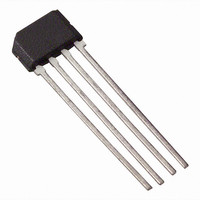MLX90215EVA Melexis Inc, MLX90215EVA Datasheet - Page 3

MLX90215EVA
Manufacturer Part Number
MLX90215EVA
Description
IC SENSOR PROG LINEAR HALL 4SIP
Manufacturer
Melexis Inc
Type
Linear - Programmabler
Specifications of MLX90215EVA
Sensing Range
Unlimited
Voltage - Supply
4.5 V ~ 5.5 V
Current - Supply
6.5mA
Current - Output (max)
2mA
Output Type
Analog, Ratiometric
Features
Regulated Voltage
Operating Temperature
-40°C ~ 85°C
Package / Case
4-SIP
Lead Free Status / RoHS Status
Lead free / RoHS Compliant
Other names
90215DB106
Available stocks
Company
Part Number
Manufacturer
Quantity
Price
Company:
Part Number:
MLX90215EVA
Manufacturer:
MELEXIS
Quantity:
5 000
The Hall-Effect
The Hall-Effect principle is named for physicist Edwin Hall. In 1879 he discovered that when a conductor or
semiconductor with current flowing in one direction was introduced perpendicular to a magnetic field a voltage
could be measured at right angles to the current path.
The Hall voltage can be calculated fromV Hall = B where:
V Hall = emf in volts
B =
I =
The initial use of this discovery was for the classification
of chemical samples. The development of indium arsenide
semiconductor compounds in the 1950's led to the first
useful Hall effect magnetic instruments. Hall effect sen-
sors allowed the measurement of DC or static magnetic
fields with requiring motion of the sensor. In the 1960's
the popularization of silicon semiconductors led to the
first combinations of Hall elements and integrated ampli-
fiers. This resulted in the now classic digital output Hall
switch. (right)
The continuing evolution of Hall transducers technology saw a progression from single element devices to dual
orthogonally arranged elements. This was done to minimize offsets at the Hall voltage terminals. The next pro-
gression brought on the quadratic of 4 element transducers. These used 4 elements orthogonally arranged in a
bridge configuration. All of these silicon sensors were built from bipolar junction semiconductor processes. A
switch to CMOS processes allowed the implementation of chopper stabilization to the amplifier portion of the
circuit. This helped reduce errors by reducing the input offset errors at the op amp. All errors in the circuit non
chopper stabilized circuit result in errors of switch point for the digital or offset and gain errors in the linear out-
put sensors. The current generation of CMOS Hall sensors also include, a scheme that actively switched the
direction of current through the Hall elements. This scheme eliminates the offset errors typical of semiconduc-
tor Hall elements. It also actively compensates for temperature and strain induced offset errors. The overall
effect of active plate switching and chopper stabilization yields Hall-Effect sensors with an order of magnitude
improvement in drift of switch points or gain and offset errors.
Melexis uses the CMOS process exclusively, for best performance and smallest chip size. The developments to
Hall-Effect sensor technology can be credited mostly to the integration of sophisticated signal conditioning cir-
cuits to the Hall IC. Recently Melexis introduced the world’s first programmable linear Hall IC, which offered
a glimpse of future technology. Future sensors will programmable and have integrated microcontroller cores to
make an even “smarter” sensor.
=
V
H
sensitivity in Volts/Gauss
applied field in Gauss
bias current
No Magnetic
Field
V
H
V
H
Magnetic Field
South
Hall
Plate
V
V +
V
H
DD
Digital Hall Effect Switch
Differential
Amplifier
V
H
North Magnetic
Field
Schmidt
Trigger
Output
G N D
V
Output
H
GND



















